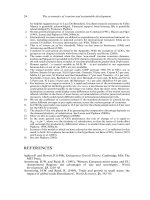THE ECONOMICS OF MONEY,BANKING, AND FINANCIAL MARKETS 583
Bạn đang xem bản rút gọn của tài liệu. Xem và tải ngay bản đầy đủ của tài liệu tại đây (36.08 KB, 1 trang )
CHAPTER 21
The Demand for Money
LE A RNI NG OB JE CTI VE S
After studying this chapter you should be able to
1. describe how the demand for money is determined
2. define the theories of the demand for money (classical and Keynesian
theories and Milton Friedman s reformulation of the quantity theory of
money)
3. present empirical evidence on how the demand for money is affected by
changes in interest rates and the level of income
PRE VI EW
In earlier chapters we spent a lot of time and effort learning what the money supply is, how it is determined, and what role the Bank of Canada plays in it. Now we
are ready to explore the role of the money supply in determining the price level
and total production of goods and services (aggregate output) in the economy.
The study of the effect of money on the economy is called monetary theory, and
we examine this branch of economics in the chapters of Part VII.
When economists mention supply, the word demand is sure to follow, and
the discussion of money is no exception. The supply of money is an essential
building block in understanding how monetary policy affects the economy
because it suggests the factors that influence the quantity of money in the economy. Not surprisingly, another essential part of monetary theory is the demand
for money.
This chapter describes how the theories of the demand for money have evolved.
We begin with the classical theories refined at the start of the twentieth century by
economists such as Irving Fisher, Alfred Marshall, and A. C. Pigou; then we move on
to the Keynesian theories of the demand for money. We end with Milton Friedman s
modern quantity theory.
A central question in monetary theory is whether or to what extent the quantity of money demanded is affected by changes in interest rates. Because this issue
is crucial to how we view money s effects on aggregate economic activity, we
focus on the role of interest rates in the demand for money.1
1
In Chapter 23 we will see that the responsiveness of the quantity of money demanded to changes in
interest rates has important implications for the relative effectiveness of monetary policy and fiscal
policy in influencing aggregate economic activity.
551









